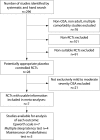Continuous positive airway pressure reduces daytime sleepiness in mild to moderate obstructive sleep apnoea: a meta-analysis
- PMID: 16467072
- PMCID: PMC2111183
- DOI: 10.1136/thx.2005.050583
Continuous positive airway pressure reduces daytime sleepiness in mild to moderate obstructive sleep apnoea: a meta-analysis
Abstract
Background: Obstructive sleep apnoea syndrome (OSAS) affects an estimated 2-4% of the middle aged population. Meta-analyses of randomised controlled trials have shown that the severe presentation of the syndrome (apnoea hypopnoea index (AHI) >30/hour) is effectively treated with continuous positive airway pressure (CPAP). Until recently there have been insufficient data to determine whether CPAP improves sleepiness in the larger subgroup with mild to moderate OSAS (AHI 5-30/hour).
Methods: A systematic search of Medline and a hand search identified seven randomised controlled trials where CPAP was compared with either a placebo or with conservative management in the treatment of mild to moderate OSAS (AHI 5-30/hour). All trials used the Epworth Sleepiness Scale (ESS), four used the Multiple Sleep Latency Test (MSLT), and three used the Maintenance of Wakefulness Test (MWT) to measure sleepiness.
Results: Meta-analyses indicated that CPAP significantly reduced subjective daytime sleepiness (ESS) by 1.2 points (95% CI 0.5 to 1.9, p = 0.001), improved objective daytime wakefulness (MWT) by 2.1 minutes (95% CI 0.5 to 3.7, p = 0.011), but did not affect objective daytime sleepiness (MSLT, mean benefit -0.2 minutes, 95% CI -1.0 to 0.6, p = 0.6). The two significant effects were small (effect size <0.30).
Conclusions: CPAP elicits small improvements in subjective sleepiness and objective wakefulness in people with mild to moderate OSAS. However, the effects on sleepiness are of limited clinical significance.
Conflict of interest statement
Competing interests: none.
Similar articles
-
Modafinil improves daytime sleepiness in patients with mild to moderate obstructive sleep apnoea not using standard treatments: a randomised placebo-controlled crossover trial.Thorax. 2014 Mar;69(3):274-9. doi: 10.1136/thoraxjnl-2013-203796. Epub 2013 Nov 28. Thorax. 2014. PMID: 24287166 Clinical Trial.
-
Randomised controlled crossover trial of humidified continuous positive airway pressure in mild obstructive sleep apnoea.Thorax. 2005 May;60(5):427-32. doi: 10.1136/thx.2004.032078. Thorax. 2005. PMID: 15860720 Free PMC article. Clinical Trial.
-
Findings of the Maintenance of Wakefulness Test and its relationship with response to modafinil therapy for residual excessive daytime sleepiness in obstructive sleep apnea patients adequately treated with nasal continuous positive airway pressure.Sleep Med. 2016 Nov-Dec;27-28:45-48. doi: 10.1016/j.sleep.2016.06.035. Epub 2016 Oct 27. Sleep Med. 2016. PMID: 27938918 Clinical Trial.
-
Pressure modification or humidification for improving usage of continuous positive airway pressure machines in adults with obstructive sleep apnoea.Cochrane Database Syst Rev. 2019 Dec 2;12(12):CD003531. doi: 10.1002/14651858.CD003531.pub4. Cochrane Database Syst Rev. 2019. PMID: 31792939 Free PMC article.
-
Myofunctional therapy (oropharyngeal exercises) for obstructive sleep apnoea.Cochrane Database Syst Rev. 2020 Nov 3;11(11):CD013449. doi: 10.1002/14651858.CD013449.pub2. Cochrane Database Syst Rev. 2020. PMID: 33141943 Free PMC article.
Cited by
-
Continuous positive airway pressure treatment of sleepy patients with milder obstructive sleep apnea: results of the CPAP Apnea Trial North American Program (CATNAP) randomized clinical trial.Am J Respir Crit Care Med. 2012 Oct 1;186(7):677-83. doi: 10.1164/rccm.201202-0200OC. Epub 2012 Jul 26. Am J Respir Crit Care Med. 2012. PMID: 22837377 Free PMC article. Clinical Trial.
-
Current Management of Residual Excessive Daytime Sleepiness Due to Obstructive Sleep Apnea: Insights for Optimizing Patient Outcomes.Neurol Ther. 2021 Dec;10(2):651-672. doi: 10.1007/s40120-021-00289-6. Epub 2021 Oct 18. Neurol Ther. 2021. PMID: 34658002 Free PMC article. Review.
-
Daytime sleepiness in patients with obstructive sleep apnea and severe obesity: prevalence, predictors, and therapy.Wien Klin Wochenschr. 2014 Oct;126(19-20):619-25. doi: 10.1007/s00508-014-0591-8. Epub 2014 Sep 6. Wien Klin Wochenschr. 2014. PMID: 25193479
-
Treatment of sleep disorders after traumatic brain injury.J Clin Sleep Med. 2009 Apr 15;5(2):137-44. J Clin Sleep Med. 2009. PMID: 19968047 Free PMC article. Clinical Trial.
-
Sleep Apnea Syndrome in an Elderly Population Admitted to a Geriatric Unit: Prevalence and Effect on Cognitive Function.Front Aging Neurosci. 2020 Jan 10;11:361. doi: 10.3389/fnagi.2019.00361. eCollection 2019. Front Aging Neurosci. 2020. PMID: 31998116 Free PMC article.
References
Publication types
MeSH terms
LinkOut - more resources
Full Text Sources
Medical




